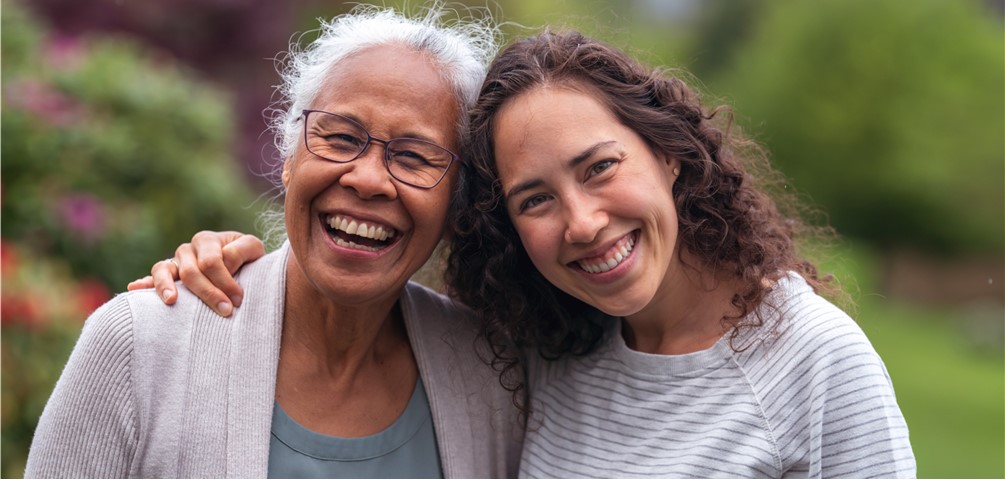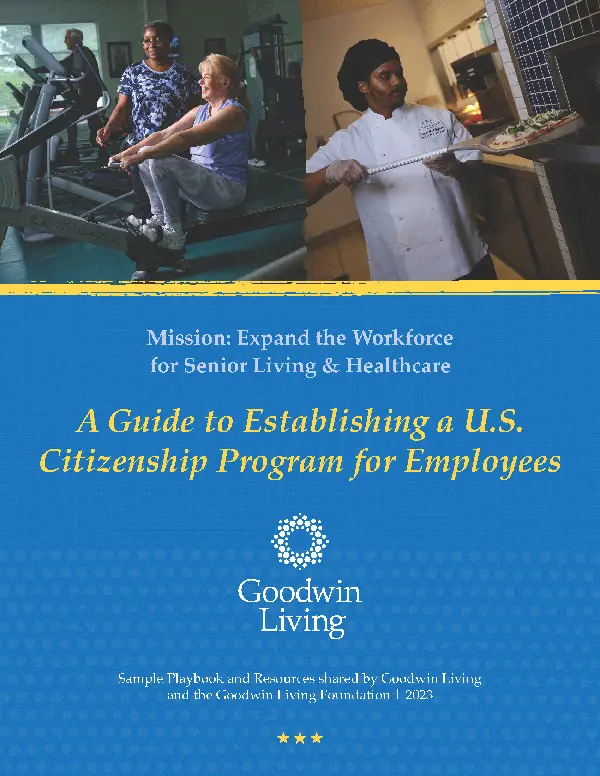
Live Wisely - May 19, 2022
By Amanda Ranowsky
In the grand scheme of things, Continuing Care at Home (CCaH) programs are relatively new. The first CCaH model came about in 1987; since then, more than 30 programs have sprung up across the U.S. Upwards of 70% of older adults want to remain in their own homes as they age, a number that has remained consistent for more than a decade. When you consider the number of people who would benefit from a CCaH, the number of programs available seems very low. Due to this, few people know how CCaH programs work or even that they exist at all.
Have you ever heard of Continuing Care at Home? Do you know what it means? We’re doing our part to support Older Americans Month and its theme—Age My Way—by sharing about CCaH programs through the voices of our CCaH experts, Beth Robinson and Cynthia McCullough.
The Administration for Community Living (ACL) leads Older Americans Month, recognized every May. This year, the theme focuses on aging in place and helping older adults plan to live independently in their homes and communities for as long as possible. CCaH programs provide care coverage and coordination to older adults as they age in their own homes, and we know first-hand how they work.
We’re proud to say that Goodwin Living is one of the organizations who stepped into the market need for CCaH programs in 2014. In just the last three years, membership in our age-in-place program, Goodwin Living At Home, has nearly doubled.
My parents are lawyers. They have saved and invested over the years and take financial planning for their future seriously. They have had experience ensuring their own parents received needed care as they aged and have navigated the twists and turns of health insurance coverage and care coordination. I know they don’t want me to have to deal with some of the situations they encountered with their parents.
So when I ask them about their plans for the future and the coverage they have in place to pay for future care needs, I’m surprised at the vague answers I receive. “We’re not ready to move out of our home,” they tell me, “so we don’t need to look at Goodwin Living yet. And we have long-term care insurance, so we’re covered if we do need care.”
My parents are not unique in their wishes or state of planning. According to the 2022 National Poll on Healthy Aging conducted by the University of Michigan Institute for Healthcare Policy and Innovation and supported by AARP, 88% of older adults want to age in place.
In contrast, 47% have given little or no consideration to the modifications their home may need as they age. 48% of those who live alone say they don’t have anyone in their lives who could help them with personal care if it was needed. And just 19% of older adults are very confident that they could afford to pay someone to help with personal care and household chores.
Those numbers tell us that many older adults want to age in their homes, though few are actually prepared to do so. That’s where a CCaH program like Goodwin Living At Home comes in.
I spoke to the directors of Goodwin Living At Home Cynthia McCullough (Sales & Product Development) and Beth Robinson (Member Services) to learn more about how CCaH programs and GLAH support older adults like my parents who want to age in place.
Beth and Cynthia chuckled when I told them about my parents. They’d heard it all before. And so, they were prepared to provide me with wonderful insights that can help us all better understand CCaH programs.
“People don’t necessarily want to leave the home they’ve cherished for many years,” said Cynthia. “A CCaH is an alternative to a Life Plan Community. CCaH programs were created to allow people to age in place and bring the continuing care portion of a Life Plan Community into their home directly.”
The CCaH model is designed for healthy individuals who are currently independent, meaning they don’t need help to perform activities of daily living (ADLs). Similar to long-term care insurance, members have a daily benefit that can be utilized to pay for care that’s brought in the home, including caregivers, housekeepers and even adult daycare. The daily benefit can also be used to pay for the cost of care in an assisted living or a skilled nursing facility.
Beyond covering the costs of care is a benefit that is worth its weight in gold: care coordination. With GLAH, that comes in the form of a Member Services Facilitator who is available 24/7 to arrange care as needed and who acts as the member’s partner in their health journey.
“Our members want to make sure that when there is a need, their needs will be met and that they have someone who is their advocate,” said Beth. “They know their Member Services Facilitator is going to listen, help them navigate the healthcare system and help them get someone in their home who is going to help with their needs.”
Like my parents, many question the need for a CCaH if they already have long-term care insurance.
“Most of our members have long-term care insurance,” said Cynthia. “What they may not have realized is that there can be a gap between when you need coverage and when your coverage actually starts.”
To qualify for your insurance benefits, many long-term care (LTC) policies require that you be unable to perform at least two activities of daily living. They also often have an elimination period before your coverage will kick in. That elimination period can range from 30 days up to a year.
“With GLAH, coverage for care starts as soon as it’s needed, and you only need to have assistance with one ADL to qualify,” said Cynthia.
Having an advocate to coordinate care means even more when you’re not feeling your best. If you are in a position to need care, do you want to be having to make calls to your insurance company? Do you know who to contact to get a caregiver? Will you feel comfortable handling a situation where you want to change providers?
“We take all those things on for the members so the only thing they need to do is work on getting well,” said Beth.
Care coordination also reduces the burden on your loved ones. “Say your parents are in the hospital and it looks like they’re going to need to go somewhere for longer-term care,” Beth told me. “The hospital is just going to give you a list of people to call to see if there is a bed at this community or that community. You may know nothing about the community you’re calling, or what you need to look for.”
Members recognize this difficulty from their own experiences. “Many of our members have experienced caring for another loved one,” said Cynthia. “They often talk about the difficulties that they faced in making the right decisions.”
With a CCaH, the benefits quickly outweigh the costs of membership. “People have no idea what the cost of personal care is,” Beth warns. “They don’t realize it’s $30 an hour or more for caregivers. If you have someone in the home eight hours a day, every day, that’s more than $200 per day, $7,000 per month, $86,000 per year.” Then there’s the costs of assisted living or skilled nursing, which climb upwards of $10,000 per month. “With a CCaH, you have a plan in place to help cover these costs,” she said.
For GLAH members, as with many CCaH programs, membership also gets you priority access to the Assisted Living, Memory Support and Health Care Center at an associated Life Plan Community. That means you have a better chance of quickly getting a bed at a community you know and trust if you need it.
There’s also room to change your mind about aging in your home. “Goodwin Living At Home also provides a bridge benefit if you decide you want to move into one of the Goodwin Living Life Plan Communities,” said Beth. “The money members pay into GLAH can be used to pay the entry fee at the Life Plan Community.”
CCaH programs like Goodwin Living At Home are attractive and viable opportunities for healthy, independent older adults to plan for the future. “Anyone who is over the age of 55 can apply,” said Beth. “Realistically, we encourage anyone who is 65+ and planning for their future needs to consider an at home program as part of their longevity plan.”
GLAH members agreed. “I think everyone’s situation is unique – the main thing is to have some security or backup if something happens to you,” said Tom Harter, who joined GLAH in 2015.
His partner Meg Lay, another GLAH member, agreed. “I was single when I first joined GLAH, and I was surprised how many couples were in the program,” said Meg. “Now that I am in a couple again, I realize that if one of us gets really ill, it would be a great help to have that backup so that you don’t lose yourself completely in looking after someone else.”
Janet Baralli uses another GLAH benefit—the Friendly Call Program—as an extra measure of security. As a single person living alone with few family members in the area, she worries about what would happen to her pets if something happened to her. Every day, she receives a text from a GLAH team member checking in on her.
“I find it very easy because it’s totally non-intrusive, and you can respond when you have time to respond,” she said. “I set a deadline: if you don’t hear back from me by a certain time something’s wrong. I accidentally texted back to the wrong person once, and GLAH contacted me later in the day to make sure I was all right!”
“Even if your long-term plan is to move to a Life Plan Community, why not have something in place that will help you maintain independence as long as possible?” Beth suggested.
I will certainly be encouraging my parents to consider joining Goodwin Living At Home, for their sakes and for mine.
________________
As Marketing & Communications Specialist, Amanda Ranowsky partners with colleagues throughout Goodwin Living to tell our stories and raise brand awareness. From printed collateral to digital marketing, Amanda covers many bases. Before joining GHI, Amanda worked for a small, family-owned business where she gained experience in content marketing. Amanda’s creative expression extends beyond the office. She is an active member of community theater and chorus groups.
